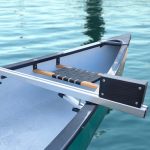In this post we have collected a whole load of tips and tricks to help you plan a multi-day kayak or canoe trip and enjoy it in full.

Portages let you take your kayaking or canoeing adventures further. Sure, they can be a total suffer-fest. But if you follow these steps and get your head down, it’s always worth the grind.
What is Kayak Portaging?
The term “portage” comes from the French word “porter”, which means “to carry”. It literally means carrying your boat and all your gear between sections of water.
If you think of the fur traders that canoed mighty rivers, they needed a way to pass unrunnable sections of water without risking their goods. They would therefore carry their boats and all their equipment around these rapids before setting off again from the other side.
In modern times, portaging is usually less strenuous than this – although it doesn’t always feel it. Our lightweight plastic or composite kayaks and canoes are much easier to carry, but our reasons are still the same.
Portaging is a way to link together bodies of water that don’t connect. You can also portage around rapids that would risk capsizing your kayak and potentially causing injuries, or that you just don’t fancy paddling.
You can portage across headlands to avoid stormy seas or wild surf launches. In short, if you’re carrying your kayak between two pieces of water, for whatever reason, you’re a certified portager.
Why Portage a Kayak or Canoe?
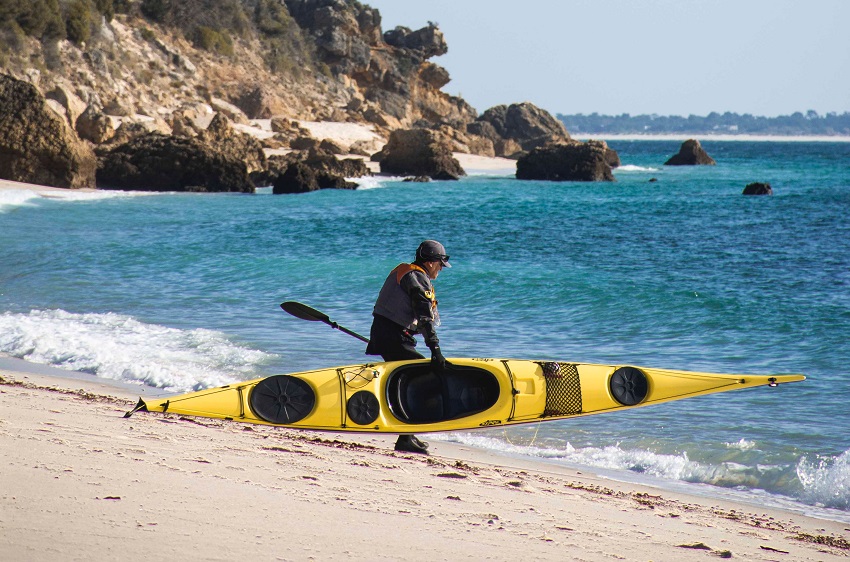
Portaging is seen by many kayakers and canoeists as an unfortunate by-product of making their journey interesting. After all, why would you go on a journey knowing that you’re going to carry your boat over the land?
There are a few reasons you might choose to portage your kayak or canoe.
Maybe you’ve reached the end of your lake and the next piece of water is just a little way down that trail. Or otherwise, you might be out on a river and reach an impassable rapid, or a rapid you don’t want to run with a kayak full of camping gear.
If you’re out on the sea, it might be a headland with a steep wall and rough weather that exposes you to undue risk that you need to move around.
Portaging takes you into places that most people don’t go. The reward for your efforts is untouched water, fishing trips deep in the backcountry, and adventures that were otherwise beyond your reach.
How to Portage a Kayak or Canoe: A Step-by-Step Guide
At this point, you might be wondering why you would need a guide for portaging. Haven’t we just told you that all there is to it is carrying your kayak?
Some portages, usually the shorter ones, are straightforward enough, especially if you can see your destination and a clear pathway. But others aren’t quite so easy.
Imagine your next lake is half a mile away through a forest. Do you really want to load everything up for one trip and head off into the unknown?
Of course you don’t. Longer portages need some planning and preparation.
Secure your Gear on the Bank
The first step for portaging your canoe or kayak is to make sure everything is properly secured on the bank.
You’ll be leaving your gear for a while. You don’t want to come back to find your canoe or kayak drifting offshore or floating past you down the river.
Secure everything else, too. Make sure your gear isn’t going to get blown away by the wind, and that nothing is going to fall out of your kayak while you’re gone.
If you’re out in the bear country, make sure all of your food is stowed in a way that won’t attract wildlife. That way, you’re less likely to have to claim back your craft on your return.
Walk Your Route
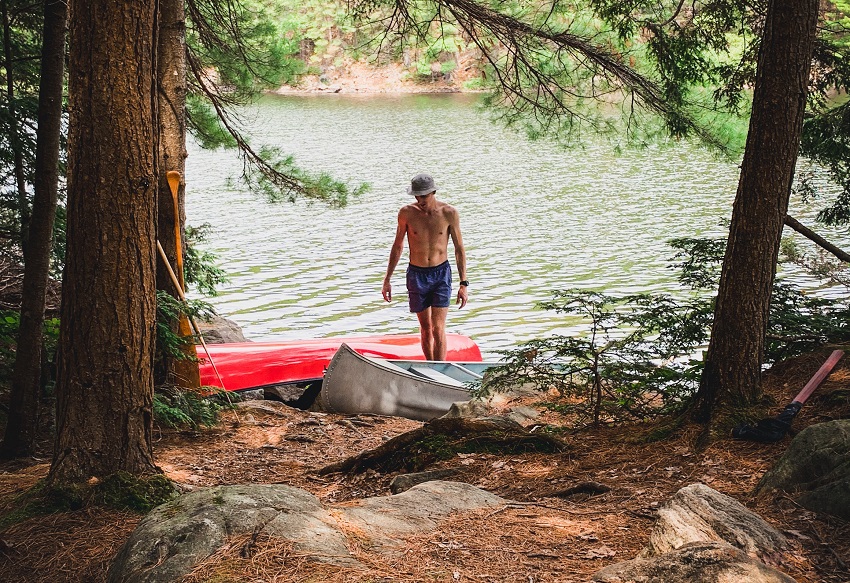
Some portage routes are straightforward, with well-worn trails leading you to the water’s edge.
Others feel a little more like bushwhacking. You might want to take a hatchet or a machete to clear a pathway before carrying your kayak and gear.
Either way, it’s recommended that you walk your portage route first before you commit to carrying all of your equipment.
If you know the route, or it’s easy to follow, then you can always load up a bag or a barrel and take that so that your first trip isn’t wasted in that sense. But if you need to navigate with a map and compass, then having a heavy bag on might be distracting.
Remember to carry safety items like bear spray, cell phones, or first aid kits with you when you head out to portage. Also, if you’re deep in the backcountry it’s a good idea to mark your trail so you remember how to retrace your steps. Try to do this in a non-destructive way: don’t hack away at trees or anything like that.
Move your Gear
Once you have your route all set, load up for the first journey.
Ideally, you want to complete your portage in as few trips as possible. But you also don’t want to risk an injury or overload yourself for the journeys.
On longer portages, it can be a good idea to move your gear in stages.
By this, I mean you should make a trip a third of the way and drop your bag, return to your canoe and do the same with the next load of gear, and so on.
Do it until your gear is all a third of the way through the portage, then repeat the process another third, then to the end.
By portaging in stages you never separate yourself and your equipment by too long a distance. This way if you get caught out by the weather, or by impending darkness, you don’t have gear at either end of the portage trail. You also get more frequent rest stages along the way, rather than carrying heavy equipment a long way in one stage.
Move your Boat
The final item to move is your canoe or kayak.
This is left until last to ensure that your trail is firmly trodden and your route is set before you set off with the heaviest item.
It also means that as soon as you get to the end of your portage route with your boat, you’re ready to go.
You can often attach lightweight dry bags to your canoe or kayak, or leave paddles on them.
Make sure these aren’t sliding around and at risk of knocking your hands though. Anything dangling over the edge of a carried canoe will start to irritate you far quicker than you might think.
Also, be sure that nothing you’re leaving onboard is going to affect the balance of your canoe or kayak. This is especially important if you’re carrying the kayak overhead or on a trolley.
Different Ways to Portage a Kayak or Canoe
There are various ways to move your canoe or kayak. Which one you choose will depend on the type of portage trail you have, the type of your canoe or kayak, and your personal preference.
How to Portage a Sit-On-Top Kayak
Sit-on-top kayaks are among the most straightforward kayaks to portage, but with their extra bulk, they can be hard work to carry long distances.
This is particularly true with fishing sit-on-top kayaks, which often have heavy features onboard.
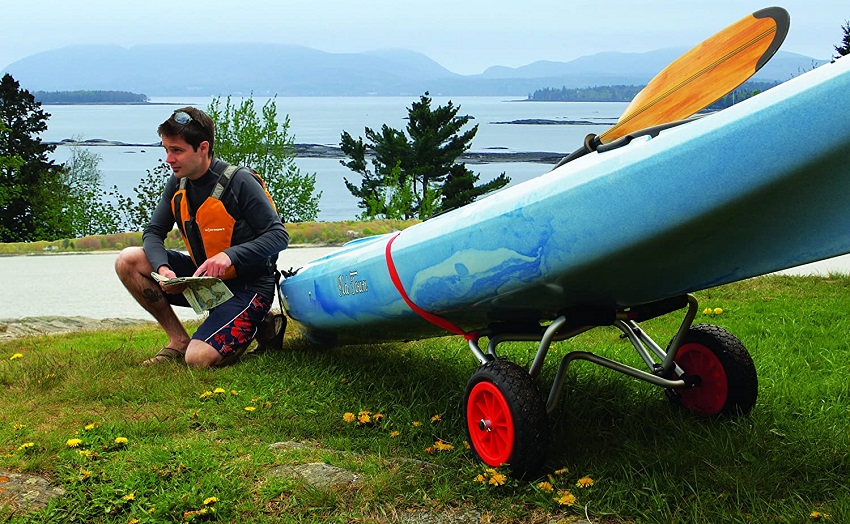
Undoubtedly, the best way to portage your sit-on-top kayak is by using a kayak trolley. That way, you can just strap it on and head off down the trail.
Remember to attach your trolley just behind the mid-point of your kayak for the best balance and to avoid over-straining yourself.
If the trail is too rugged for your trolley to pass, you may have to resort to manual labor to move your kayak. That means either carrying or dragging your sit-on-top kayak over the ground.
Only drag your kayak if you are certain that the ground is soft and isn’t going to damage your hull. Make sure you aren’t going to damage the area you’re dragging through.
How to Portage a Sit-In Kayak
Most kayakers choose to carry their sit-in kayak by picking it up and placing it on their shoulder. Don’t worry, it’s not as uncomfortable as it sounds, but it’s definitely a better option with lighter kayaks, like recreational or whitewater models.
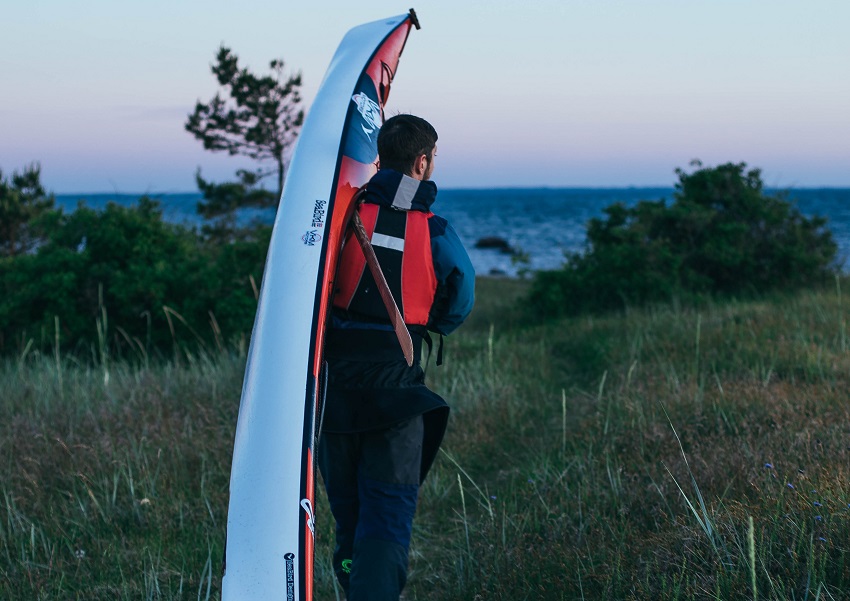
To do this without damaging your back, follow these steps:
- Crouch down and lift the front of your kayak, standing it upright with the stern on the ground.
- Stand alongside your kayak with your carrying shoulder just inside the cockpit.
- With the same hand, hold the front of the cockpit and roll the kayak forwards so it lands on your shoulder around where your hips would be.
If this doesn’t work for you, there are other options:
For larger kayaks that won’t fit on your shoulder, you can buy a carrying yoke similar to those found on canoes. The yoke sits over the cockpit, letting you place the kayak upside-down on your head for carrying comfort.
For shorter kayaks, you can also buy carrying straps that essentially turn your kayak into a backpack. These are most commonly used by expedition whitewater kayakers who often carry their kayaks for many kilometers at a time to access remote rivers where there aren’t roads.
You can also use trolleys for sit-in kayaks, as you would with a sit-on-top.
Trolleys are very useful for portaging touring kayaks. They help to avoid unpacking all the many dry bags that you’ve stuffed into the hatches.
If you are going to portage like this, be sure to spread the weight on the trolley so you aren’t putting undue pressure on any one part of your kayak.
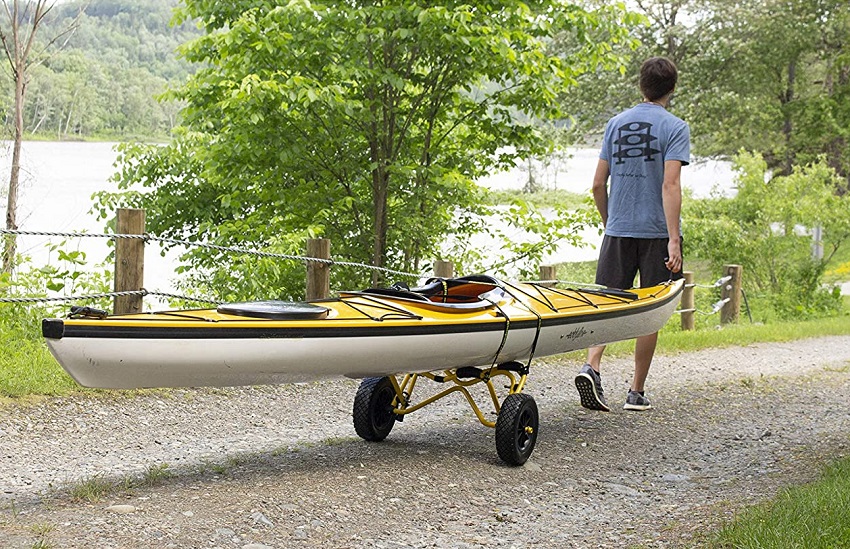
How to Portage a Canoe
When you mention the word “portage”, most people’s minds instantly go to canoes.
Canoes were traditionally used for long-distance journeys and carrying heavy loads. While they’re no longer used in the same way commercially, canoes are still popular for long-distance journeys, which sometimes include portages.
Portaging a Canoe with a Carrying Yoke
The carrying yoke fitted into the middle of your canoe serves a double purpose. It’s partly fitted for lateral strength, to prevent your canoe from folding easily under pressure.
But the reason it’s shaped like that is to fit around your neck, taking its name from the carrying yokes used on animals – like yaks – in the field.
Loading your canoe onto your head can be hard work. Many standard yokes aren’t designed for long carries. A deep-dish yoke is more comfortable, and if you are going to be portaging regularly, it is something you should consider.
Maneuvering a canoe onto your head is easiest with a partner, but can be done alone:
- Lift the rear of the canoe up and above your head, leaving the bow on the ground.
- Holding the gunwales, move forward until the yoke is over your shoulders, then gently rock the canoe back until it’s balanced over your head.
- Be careful when carrying a canoe this way as a twisted knee or putting your foot into a hole can cause the whole thing to come crashing down.
Portaging a Canoe with a Trolley
As with sit-on-top kayaks, the most popular way to portage a canoe is to use a portage trolley.
Simply unfold your trolley and attach it underneath the center of gravity of your canoe.
Most people choose to strap their trolley to their canoe at this point, using the yoke or a thwart to secure it in place.
If you are going to leave your gear in the canoe while you portage on a trolley, center it above the trolley. That way you are less likely to bend or break your canoe.
Portaging a Canoe by Pair Carrying
On short portages, you can simply carry your canoe with a partner. This isn’t an ideal way to move a canoe as handles tend not to be the most comfortable things in the world, but it can be useful in many cases.
Perhaps the simplest way to make carrying a canoe easier is to add more people. There’s a balance with carry-portaging a canoe between efficiency and ease and it’s up to you to decide how many people you want carrying each canoe.
If you are going to carry your canoe with four – rather than two – people, then you’re best off carrying it by the gunwales:
- Stand on either side of the front and rear seats, all facing the bow of the boat
- Wrap your hands under the gunwales and lift together.
This method spreads the weight of the boat more efficiently than using the end handles and mid-point, where everyone ends up lifting to different heights.
Dragging a Canoe – Useful Tips
Like with the sit-on-top kayaks, you can always drag your canoe across open ground, so long as you’re not going to damage it.
The hard part here is getting the canoe moving. You may need a hand from a buddy to get some momentum.
Painters – ropes at either end – are more comfortable than the handles, because you don’t have to hunch over the canoe.
The most comfortable way to drag a canoe is to lay the rope over your shoulder, using your PFD shoulder straps for padding. Then, holding the rope down in front of you, begin walking forwards and drag your canoe.
Dragging isn’t exactly a refined technique. But when you’re moving through swamps or marshes, or if the ground is full of holes and you risk twisting a knee, it can help to protect you from injury.
Final Thoughts
Don’t let the fear of portages keep you from getting into new places. It is a skill that can be mastered. And, as we said above, in most cases it is well worth the grind.
Happy paddling!





